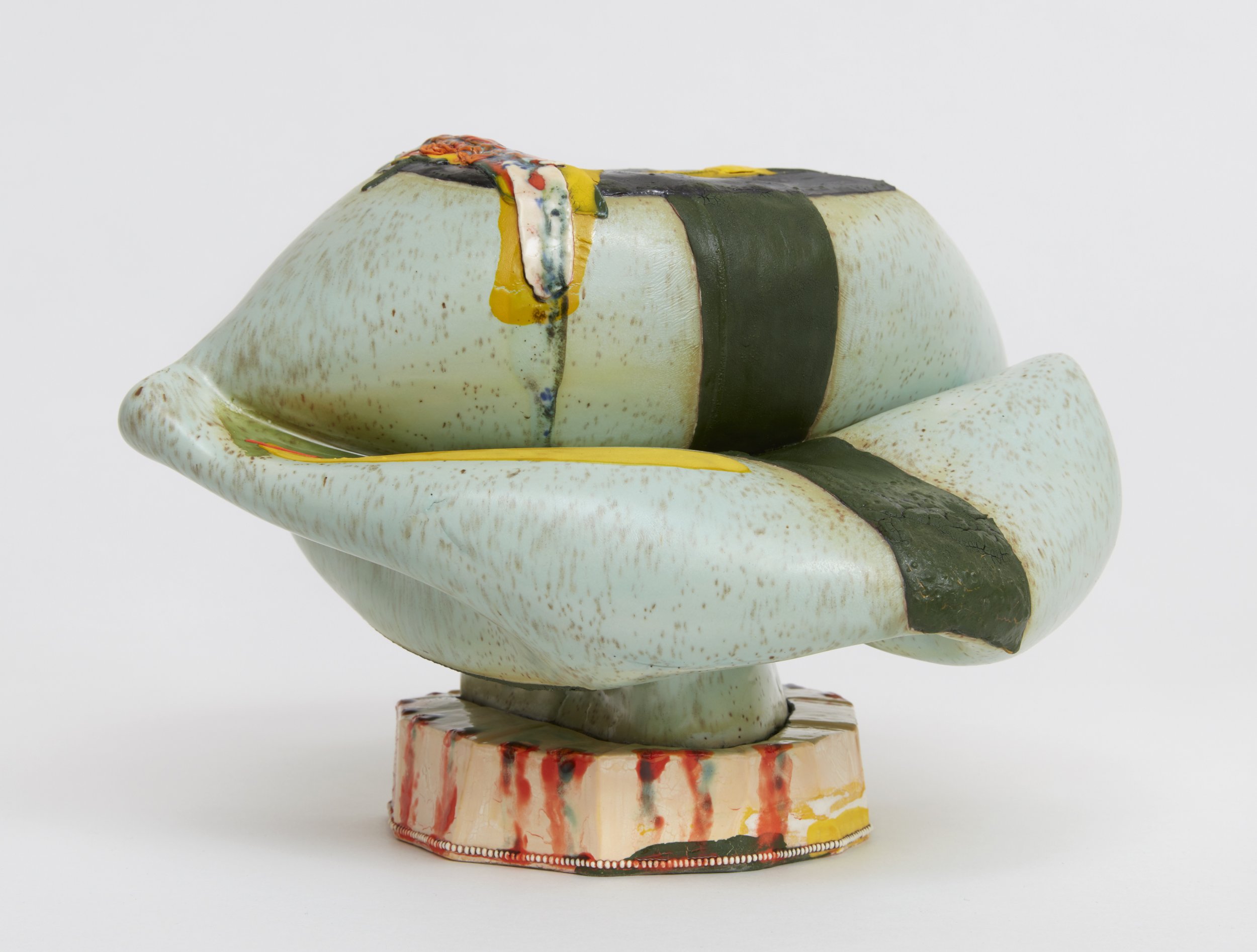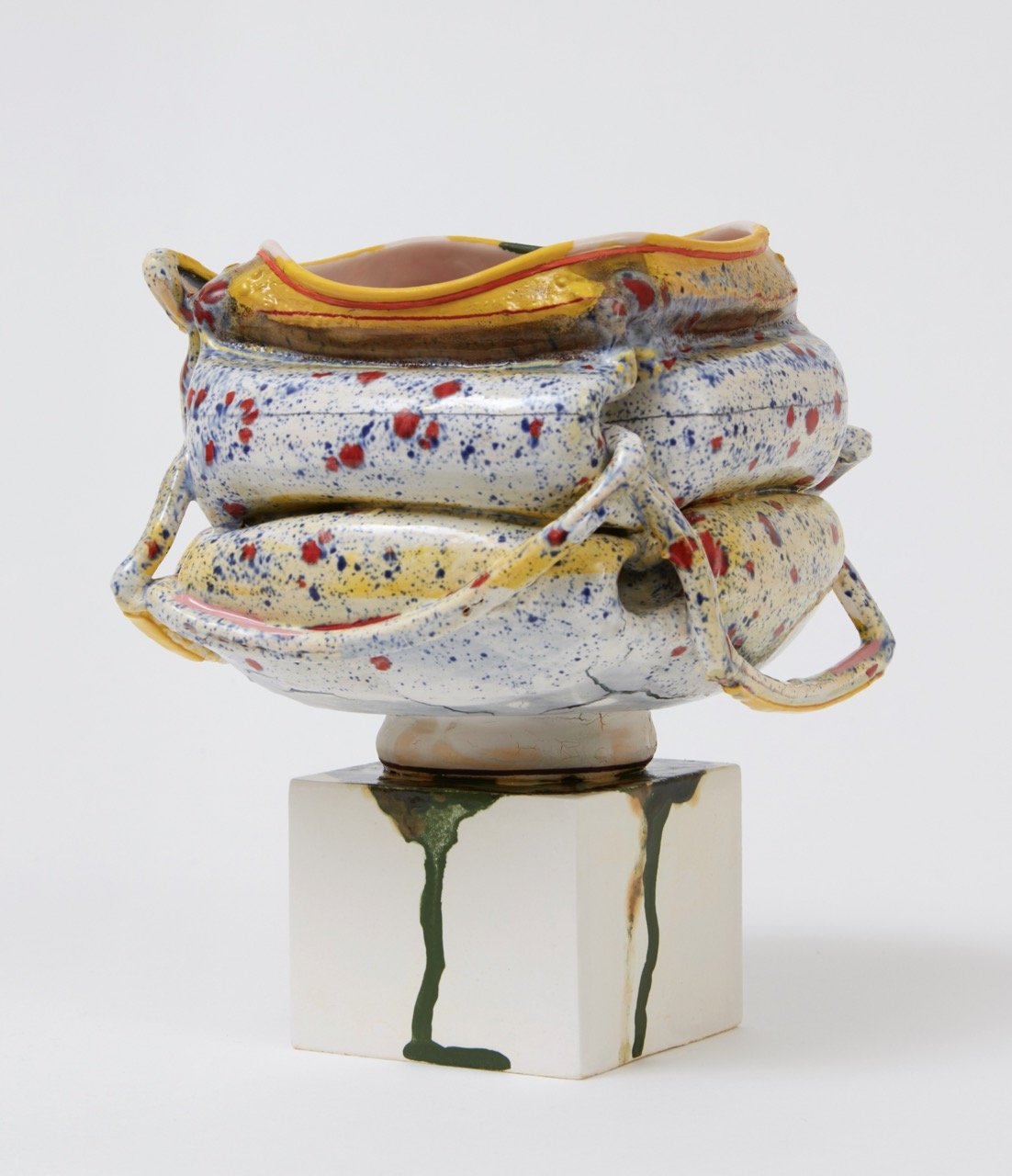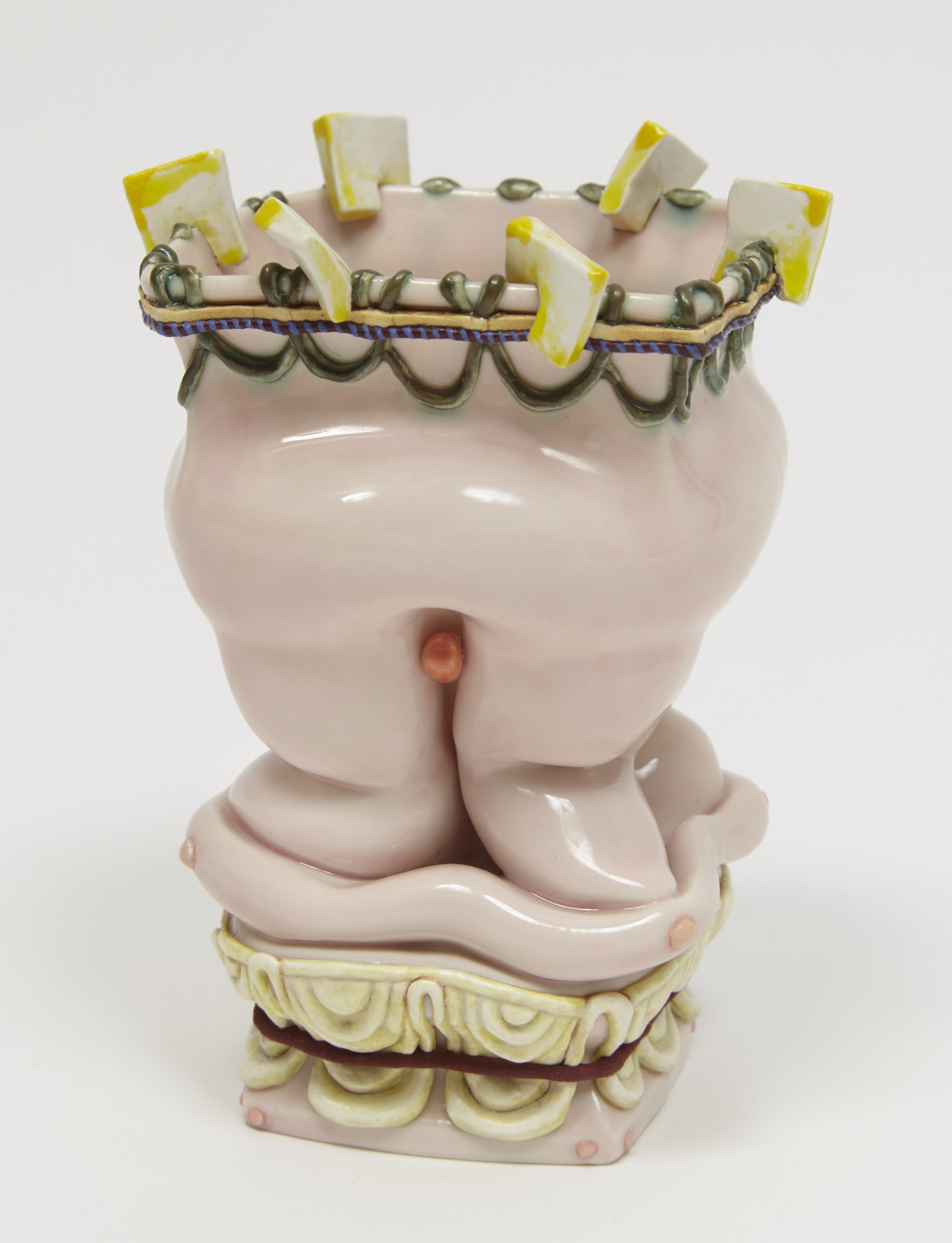BOMB Magazine: Kathy Butterly Interviewed by Kendall DeBoer
Vibrant, biomorphic ceramics that imbricate feelings and form.
Kathy Butterly, Super Bloom, 2019, clay, glaze, 6.25 × 9.5 × 10 inches. Courtesy of the artist and James Cohan, New York City. Photo by Alan Wiener. © Kathy Butterly 2021.
This article appears in BOMB Magazine.
I first encountered Kathy Butterly’s playful, colorful, bodily, and bizarre ceramics while working at the Museum of Fine Arts, Houston. There, her 1996 vessel Silk Worm mesmerizes and entices with fleshy tones and skin-like folds. Its title suggests a larva-cocoon-to-moth metamorphosis that’s animate, beautiful, sticky, gooey, destructive, and productive. To my delight, I would soon find that these qualities are characteristic of Butterly’s oeuvre, which spans decades.
Intimately scaled and deliciously complex, Butterly’s sculptures emote, provoke, and insinuate. Two series of her ceramics—one from 1996 to 2018 that riffs on the pint glass, and a group of recent work made since 2019—are currently on view at the Portland Museum of Art (PMA) in Maine for Kathy Butterly: Out of one, many / Headscapes. The show attests to her porcelain works’ consistent strength and charm as well as Butterly’s ongoing dedication to the alluring and disconcerting, the enchanting and discomfiting, as she invites us into her world.
—Kendall DeBoer
Kendall DeBoer: Let’s talk about your material and medium of choice, ceramics, which has always occupied multiple artistic landscapes and defied categorization.
Kathy Butterly: My work straddles painting and sculpture. Early on I never imagined myself working with clay, and, clearly, I love it. But when I went to art school at Moore College of Art for undergrad, my favorite thing was painting; and yet ceramics chose me. I thought pottery was all about utility and function; then Viola Frey came after she had her solo show at the Whitney. I met her and witnessed her giving a demonstration, which changed my life. I said, “This is it. This is what I need to do.” I started working large à la Viola, and then when I went to grad school in California my work changed drastically and became smaller.
KDB: I read a quotation in your recently published monograph where you say, “Frey showed me that clay was art. And it was about painting and sculpture, two things that I loved, and how now I saw that I could have it all.” Could you share more about your love for painting and its relationship to your ceramics?
KB: In terms of painting, I’m interested in how colors work together, how layering them creates history. I build up color as you would in painting, intuitively, but with the step of firing it in between. I’m working on a piece right now that’s driving me nuts. It’s going into the thirties of firings. I don’t sketch out anything before, and the process and the materials take the piece where it wants to go. It’s frustrating at times. Quite often I am lost and don’t know where the work’s going, but I trust this process and the unknown—it takes the work further.
Kathy Butterly, Crossed Arms, 2019, clay, glaze, 6.25 × 6.25 × 6.25 inches. Courtesy of the artist and James Cohan, New York City. Photo by Alan Wiener. © Kathy Butterly 2021.
KDB: I like the openness with which you talk about different emotional relationships to the process and to the works.
KB: The way I like to talk passionately about my work really strikes people. And I don’t understand why. Is it, like, weak, female, whatever to talk about emotions and passions? All the things that I was taught that you shouldn’t talk about are the things that I am about. I think it’s strange not to talk about these things.
There are formal qualities within my work that I am interested in. My last show in New York was so much about creating feeling from a limited set of forms. Each work has a cube, and each piece came from the same fishbowl shape. This body of work would combine two concepts—one more “formal” and one more “emotive.”
KDB: I think form and emotion are interconnected. Different forms give us different feelings. Feelings have form, you know? I’ve seen your work described as anthropomorphic, almost alive or animate—like human beings.
KB: Because I’ve been working thirty-five years or more with clay, my materials are like family to me. The colors do have personalities and feelings. I like how emotive colors are with glaze, especially. I think about the translucency of color. Color can dry opaque or become fluid and gorgeous.
I have two kids who are now adult children; but they, like my work, came from the same place. They came from my body and my husband’s, and yet they’re so different from each other. My recent ceramic forms all came from a fishbowl shape, but they have unique personalities. My job is to create this form and then to help it get to where it needs to be in terms of persona and what it needs to express.
KDB: I wanted to ask about your recurring use of ready-made casts. This method also informed the works currently on view at the Portland Museum of Art, like your Out of one, many series, which has a single pint-glass form as its basis.
KB: Conceptually, I like the idea of a ready-made and taking something that’s store-bought and generic and creating something unique and individualized from it. It started with a pint glass because I was enamored with the idea of creating sculptural forms from a cup form. I wanted to do a cup series for years, but I can’t just make something; a portal or door has to open so that I can feel free. The thing that opened the door for me was that my husband went up to Yale and brought back a catalogue of Mayan ceramics. They were vessel-like cup forms with images all the way around them.
Kathy Butterly, Tangsome, 2015, clay, glaze, 5 × 5.5 × 2.25 inches. Courtesy of the artist and James Cohan, New York City. Photo by Alan Wiener. © Kathy Butterly 2021.
KDB: I was wondering about the role of decoration or adornment in your work. By that I mean the different ornaments like the tiny pearlescent beading moments, or a miniature drinking straw, or things like that.
KB: You know, I really don’t like that word decoration.
KDB: Really?
KB: Yeah. For me, it’s more about line or gesture, and they have deep meaning. Because of the scale of my work, if I make something precious and detailed, it pulls you in. You stay longer and get sucked into my world. The works are small, but when I’m working they’re huge because I’m only looking at, like, three inches at a time. They become universes to me. The beads are sculpted so that each one is handcarved in place. They can take two solid weeks of carving and then glazing them. It’s backbreaking work, and so it’s funny how they’re small, and they’re delicate, but they’re backbreaking.
KDB: Yes, ceramics are incredibly labor-intensive. To do anything with clay—to even wedge clay—is a very full-body, physical activity.
KB: It’s such a great material. It shows its scars. If ceramics go through thirty-something firings, they show that they’ve been through something—which is emotive. Back to the pearl thing: first it was a way of just having a line that continues around the form while also meaning that these are more female-oriented forms. As I’ve changed and developed, the idea of what the beads are changed and developed too.
Making these white pearls, I’m like, “They’re my power pearls.” I listen to public radio and the news of all this shit that’s happening in the world while I’m working. It’s so stressing; it’s an irritant. And I think of how a pearl is a piece of sand that goes into an oyster. The oyster is irritated. So what does it do? It creates something soft and beautiful from an irritant. That was the meaning: creating something beautiful and powerful out of a situation. And then during Covid, they took on a different meaning. The world is so out of control, and this is something that I can control in my studio. I’m going to make these perfect worry beads, adding intentionality and love and compassion to pieces that were feeling very out of control.
KDB: A lot of these words—beauty, love, compassion—are taboo in the art world. I find it juicy that you don’t like the term “decoration” because that’s often a taboo word in the art world too.
KB: I think that decoration seems to suggest there’s not weight to it. These have heaviness. They’re mixed, so they’re full of love and tenderness; but they’re also reflecting the world in a chaotic situation. I think of the worry beads as a heavy, heavy, heavy necessity, rather than something just decorating a piece.
Kathy Butterly, Like Butter, 1997, clay, glaze, 4.5 × 3.75 × 3.5 inches. Courtesy of the artist and James Cohan, New York City. Photo by Alan Wiener. © Kathy Butterly 2021.
KDBRight. I think that whenever we love anything there is heaviness. When has love ever not included some sort of painful element or an element of loss?
KB: Totally. Tragedy and loss are things we are not supposed to talk about. I freely talk about this, and early on people would tell me not to. When I had my son, I went into labor in my studio. Two months later, I had a solo show in New York. I had a guy come up to me and say, “I can’t believe you brought your son to your opening. The art world isn’t going to take you seriously.” That made it pretty clear to me that I had to work extra hard to get similar visibility to a male artist. This stuff that you’re not supposed to say and do. I just do what feels natural to me.
A piece in the PMA show entitled Like Butter (1997) is from when my husband and I just got married and were passionately in love. I knew it was evocative, but I didn’t know how in-your-face sexual and naughty, or whatever, it was. A person responded to the work like, “Oh, that piece just disturbs me so greatly.” And I was like, I love that you are so uncomfortable. Because it’s just clay, and it’s making you feel uncomfortable. It was so innocent. That’s how I was feeling. We all have that experience. We all have this love and tender feeling; why can’t I put it out there?
KDB: I’d love to hear more about the gendered elements of your work.
KB: The works are an extension of myself. It’s from my point of view. Because they’re abstracted, I also think they’re open to interpretation. But, yes, they’re very female; and I’m proud of that. Especially starting out in the time that I did with ceramics. I was making these small, little pink things in New York City that you wouldn’t think would be popular. But I always find an audience to appreciate the work. Being honest and true is a big strength. I used to teach, and I would say “Everybody, stop thinking about what people think, and just make what you need to make.”
Kathy Butterly: Out of one, many / Headscapes is on view at the Portland Museum of Art in Portland, Maine, until March 5.




